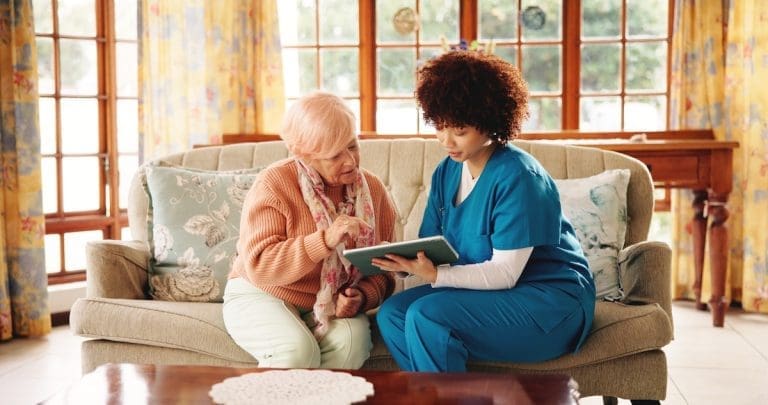Nursing has long been a highly stressful career. A 2018 and 2019 survey of more than 3,000 nurses discovered that within a single year, 54% reported moderate to severe burnout, characterized by increases in exhaustion, depersonalization, and a reduced sense of personal accomplishment.
Unfortunately, COVID-19 has only exacerbated an already serious issue for healthcare organizations. A survey in the height of COVID-19 on nurse satisfaction found that “93% [of nurses] were experiencing stress, 86% reported experiencing anxiety, 77% reported frustration, 76% reported exhaustion and burnout symptoms, and 75% said they were overwhelmed.”
COVID’s Impact on Nurse Burnout
During COVID, nurses battled a variety of issues that aggravated feelings of physical or emotional exhaustion and burnout, whether it was a lack of PPE or personal health safety concerns. A recent survey found that the most commonly cited challenges were:
- Inadequate staffing (53%)
- Difficulty meeting work and family obligations (28%)
- Wished for more adequate support programs for emotional needs and well-being (25%)
- Suffered compassion fatigue in dealing with traumatic events (25%)
Additionally, according to the American Hospital Association, one of the most difficult day-to-day issues nurse practitioners faced was how to properly communicate and implement changing policies.
To make matters more challenging, nursing professionals are increasingly being asked to shoulder more responsibilities—many of which are either non-clinical in nature or rely on inefficient and time-consuming manual workflows. Whether it’s handling room comfort calls or interfacing with complicated technology platforms, these tasks drain time and energy that could otherwise be spent on providing patients with expert patient care.
3 Ways to Change the Narrative from Nurse Burnout to Nurse Satisfaction
#1 Free Nurses From Non-Nursing Tasks
A recent study by researchers at The University of Illinois at Chicago dubbed these non-value added tasks the “million dollar nursing opportunity.” Nurses serve as the hub of patient care, so inefficient workflows and cumbersome handoffs in everything from ADT processes to medication and diagnostics documentation and patient communication result in “wasted time (that) leads to both high costs and nurse dissatisfaction,” the researchers noted.
Patient smart room technology automates non-value added, non-clinical nursing staff tasks and clinical workflows. Integrating the hospital’s technology platforms enables the nurse to benefit from the full power of those technology investments, through automated, streamlined, smart room capabilities that put patient care time back into their day.
Imagine if a patient could use their hospital room TV or another connected device to order their own meals from a menu specifically customized to their dietary requirements – with no need to push a nurse call button to assist.
Consider the smart patient room that integrates the interactive patient experience platform on the TV with the hospital’s HVAC platform, enabling the patient to control their room environment without asking for nursing help. Not only is the nurse freed from non-clinical tasks, but patient experience is improved – and bonus: the hospital stands to save significant energy costs.
Or, imagine the impact to hospital throughput in a smart room environment in which ADT, integrated with the interactive patient experience platform, is automatically alerted when a patient is moved or discharged.
Look for interactive patient experience smart room technology capable of capturing and transmitting data and integrating with various hospital platforms so that information and work can flow freely between:
- EMR
- ADT
- HVAC
- Dietary
- Pharmacy
Hospitals that do this experience improved nurse and patient satisfaction as well as better overall health outcomes.
#2 Improve the Way Communication Flows Between Clinical Staff and Patients
Communication is critical for instilling patient confidence and trust and has a direct impact on health outcomes. Today’s consumer patients want to be informed, engaged participants in their health care, yet, a lack of communication continues to be one of the most common complaints patients lodge against their hospital experience.
The nurse serves as the primary conduit of communication and information flow between the medical care team and the patient and their family. With an ever-increasing load of non-clinical hats to wear, an ever-growing volume of complex tech platforms to navigate, and a reliance on manual, outdated communication methods, it is no wonder that nurses feel burnout and patients feel ill-informed.
Fortunately, interactive patient experience technology has made it possible to improve nurses’ clinical efficiency and improve communication in a hospital.
Leverage digital whiteboards. Should a nurse really be spending time updating a dry erase whiteboard at every shift change? Seamlessly integrated with the hospital EMR, digital whiteboards give patients real-time updates on their care and access to their medical information and treatment plan –– without nursing’s manual intervention. The result is a win-win: around-the-clock two-way communication between patients and nurses that improves patient satisfaction and outcomes, and dramatic time savings for busy nursing units.
Incorporate digital signage. Like digital whiteboards, digital signage turns manual communication processes (like printing and distributing or posting news and notices) into automated and engaging digital communications.
Automate discharge planning. Should a nurse have to log into multiple software platforms to access/view critical patient information, like discharge readiness status or education compliance or the patient’s latest vitals? Using an integrated smart room approach, interactive patient experience technology partners with the EMR, ADT, pharmacy platforms and more to give the nurse 360-degree visibility into the patient’s care and progression toward discharge. Automated care transition planning streamlines the discharge planning process so that nurses can work more efficiently, and bonus: patients are more fully prepared for their post-acute care.
Wouldn’t it improve clinical efficiency if nurses across shift changes had visibility into EVERYTHING that went on with a patient before and after each of their shifts – in one place?
#3 Select a Technology Solution that Passes the Test of a Human-Centric Design
When hospitals look to adopt new technologies, it’s important to remember that the wrong platform could cause more harm than help. Armed with the right technology—one that passes a human-centric design test—you can improve patient experience and nurse retention. When choosing human-centered technology, consider these questions:
- Is it hospital-specific? It’s vital that every piece of technology is built specifically to address the needs of nurses and patients.
- Has it been vetted by nurses? Seek out the nurse’s voice in your evaluation. Is this a solution that truly improves nurse efficiency – or adds more work to their plate? You can empower your nurses and make them feel heard by creating an open line of communication around all technology adoption. A willingness to foster an open conversation between hospital leadership and frontline healthcare workers demonstrates that you care about what they have to say and reassures them that you’re only adopting solutions that alleviate the issues they’re facing.
- Is it easy for patients to use? If the technology is patient-facing, has it passed the patient/family test for human centeredness? Because if a patient finds it too difficult to use or not of value, a nurse is wasting valuable time educating the patient on its use.
Increasingly, hospitals are turning to patients and families to bring valuable user perspectives into the hospital experience, by forming Patient and Family Advisory Councils or PFACs. PFACs are opening the lines of communication between patients and hospital administrators, clinicians, and staff to improve healthcare quality, safety, and patient experience. They can bring valuable insights to ensure that hospital tech investments are human-centered not only for the nursing team, but for patients as well.
The Solution for Nurse Burnout
When hospitals adopt new technology, it’s vital that it fixes more problems than it causes. And when it comes to burnout prevention and empowering nurses, that technology must check three boxes:
- It frees up nurses from time-consuming non-clinical, non-value-add tasks
- It improves communication between nurses and patients
- It is made for and tested by nurses
The Sentrics E3 Patient Experience Platform is changing the nurse and patient experience, with an interactive suite of human-centered, smart technologies that automate tasks and put patients at the center of their care.
Want to reduce nurse burnout and improve clinical efficiency? Contact us to see how E3 can transform your hospital.
Sources:
- NCBI. Impact of nurse burnout on organizational and position turnover.
- https://www.ncbi.nlm.nih.gov/pmc/articles/PMC7532952/#:~:text=The%20impact%20of%20burnout%20on,a%20factor%20in%20position%20turnover
- Healthcare Finance. Healthcare workers experiencing burnout, stress due to COVID-19 pandemic. https://www.healthcarefinancenews.com/news/healthcare-workers-experiencing-burnout-stress-due-covid-19-pandemic
- JAMA. Prevalence of and Factors Associated With Nurse Burnout in the US. https://jamanetwork.com/journals/jamanetworkopen/fullarticle/2775923
- Healthcare IT News. Pandemic-era burnout: Nurses in the trenches say technology hurts and helps https://www.healthcareitnews.com/news/pandemic-era-burnout-nurses-trenches-say-technology-hurts-and-helps
- American Hospital Association. 2021 Environmental Scan. https://www.aha.org/system/files/media/file/2020/11/2021_Environmental_Scan.pdf
- Journal of Nursing Administration. Non-Value Added Time: The Million Dollar Nursing Opportunity https://www.researchgate.net/publication/23685857_Non-Value-Added_Time_The_Million_Dollar_Nursing_Opportunity



